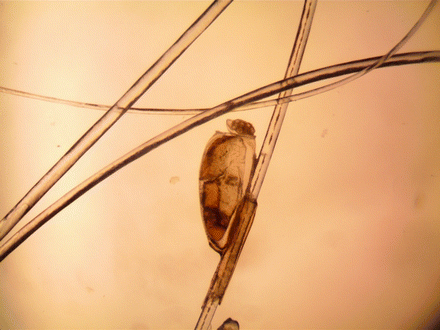Figure 33.1
Head lice
Clinical Differential Diagnosis
Seborrheic dermatitis
Insect bite
Pediculosis (Lice)
Eczema
Psoriasis
Piedra
Histopathology
Multiple strands of gray hair were removed and submitted for microscopic evaluation. Examination revealed an egg sac attached to the hair shaft (Fig. 33.2).


Figure 33.2
Unstain, 40×, head lice egg (nit) attached to hair shaft
Diagnosis
PEDICULOSIS (LICE), three types of lice species are identified; Pediculus humans capitis (head lice), Pediculus humans humans (body lice), and Phthirus pubis (pubic/crab lice Fig. 33.1). The infestation is spread by close physical contact and sharing of headgear, combs, brushes, and pillows. However, the incidence is low in blacks due to the inability of the female lice to attach their egg to curly hair. The lice eggs (nits) are easily dislodged which promotes infestation of additional individuals. These insects have three pairs of claw-like legs for grasping hair shafts. Their entire life cycle is spent on the hair where the female lice lays five to ten eggs per day. After 10 days, the eggs hatch and mature in another 14 days. Lice can survive up to 2 days away from the host, while nits can survive up to 10 days. On the scalp, the lice commonly are located on the occipital and retroauricular regions. They survive by blood-sucking the host, thus signs can include an erythematous macule with excoriation and scaling. Diagnosis is made by direct observation of nits on the hair shaft or by locating live lice using a fine comb.
Stay updated, free articles. Join our Telegram channel

Full access? Get Clinical Tree








